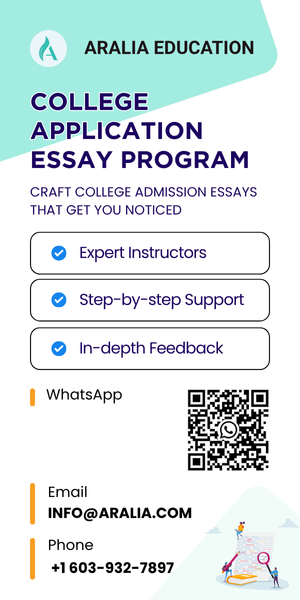What is Generative AI?
Generative AI is different from a Google search because it’s able to create new responses based on existing information. Instead of sorting through a library of websites and giving relevant suggestions based on keywords, generative AI reads the library, analyzes relevant information, and writes a summary for you. Its function is one step above data sorting; at the same time, its “generative” ability allows AI to provide false details that look convincing. While high school students may use AI to assist with writing academic papers and regular schoolwork, conducting research for a paper through platforms such as ChatGPT is unreliable.
The top five models of generative AI commonly used for writing assistance include ChatGPT, Grammarly, ARIA (Zotero plugin), Socratic by Google, and Photomath. This blog will primarily cover examples of how to use ChatGPT responsibly; however, the tips can be applied to other platforms as well. AI can be very helpful to students, and the team at Aralia encourages you to research the other top AI models to see how they can help support your learning.
How to Use AI Responsibly When Writing Your Academic Paper
Always ask your teacher first! Each class, even within the same school, follows different AI policies. Some conservative teachers may restrict AI usage completely.
Commonly acceptable ways of using AI for academic writing include brainstorming ideas, checking for grammar mistakes, and making proofreading suggestions (such as highlighting a specific paragraph or main idea point as unclear or not as strong).
AI can also help you get started on researching primary and secondary sources for your humanities research paper, but as mentioned above, be cautious of inaccurate sources and quotes, as generative AI can create convincing fakes. Always double-check with your school’s library database!
In a STEM research paper, AI can help explain the pros and cons of different research methodologies, helping you decide which methods are better suited for your project. AI can also assist with menial tasks such as generating standard consent forms for interviewees or data access, leaving you more time to work on tasks that require critical thinking.
Learn more about ways AI can support your writing process.
Master AI Tools to Gain a Competitive Edge in School and Beyond
What to Avoid: Irresponsible Ways of Using AI to Write Your Academic Paper
While AI usage regulations differ between classrooms and schools, commonly unacceptable ways of using AI in your writing process include:
- You cannot take AI-generated analysis of the historical or literary significance of a quote, event, figure, or other source, as if it is your original thought.
- AI cannot directly edit your work. If you wrote your paper and ran it through AI for proofreading, you can’t hand in its edited version as your own work. This will be marked as plagiarism.
- You cannot feed ChatGPT examples of your past work and ask it to match its tone to your personal voice.
- Finally, the most obvious, you cannot include AI-generated sentences and paragraphs in your paper.
Ways AI Can Help You with Schoolwork
Aside from academic writing, AI can support students in their daily schoolwork. See below for responsible, creative ways that generative AI can enhance your learning through personalization. Each tip includes a screenshot example from the ChatGPT-4o model from June 2025.
1. Practice chatting in a foreign language
For example, “converse with me in spanish. i’m preparing for the ap spanish language exam” (see below)
or “give me a latin text to translate”
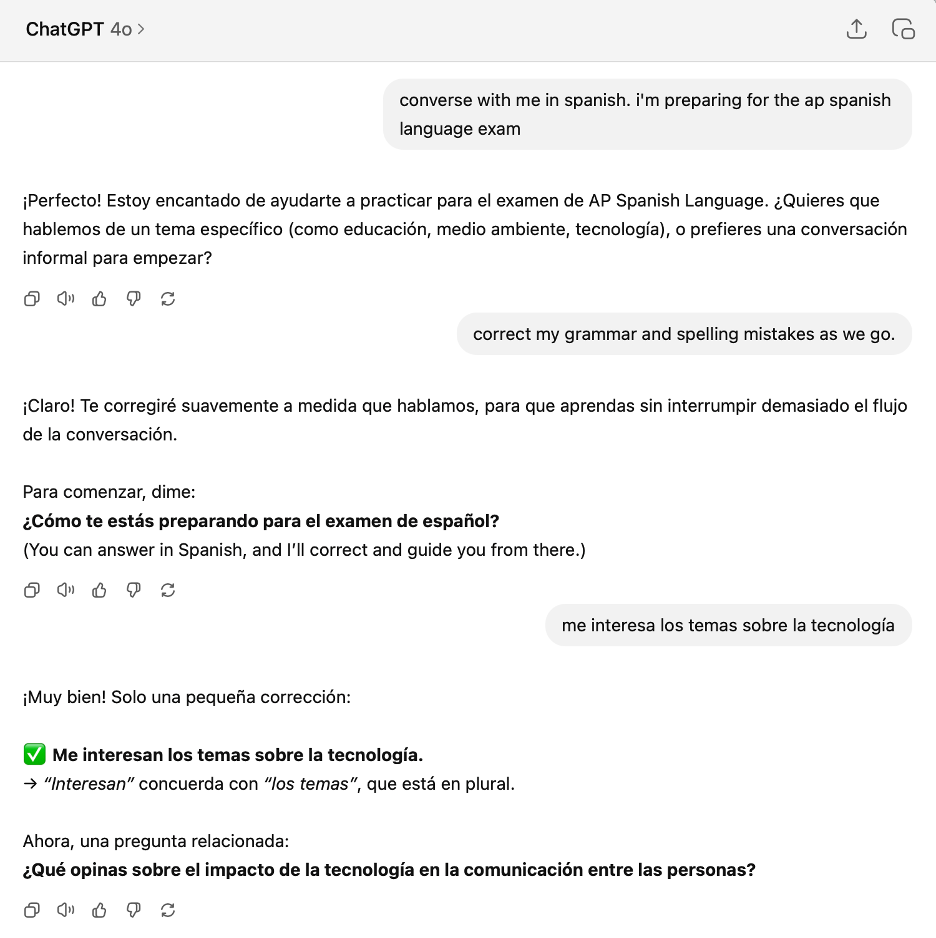
2. Use AI as a prompt generator or to test your knowledge
For example, “give me a computer science hackathon prompt in Python, suitable for a 10th grader to complete in 24 hours” (see below)
or “I’m preparing for the AP Chemistry exam. Test me on these topics: equilibrium, thermodynamics, and acids and bases” (see below)
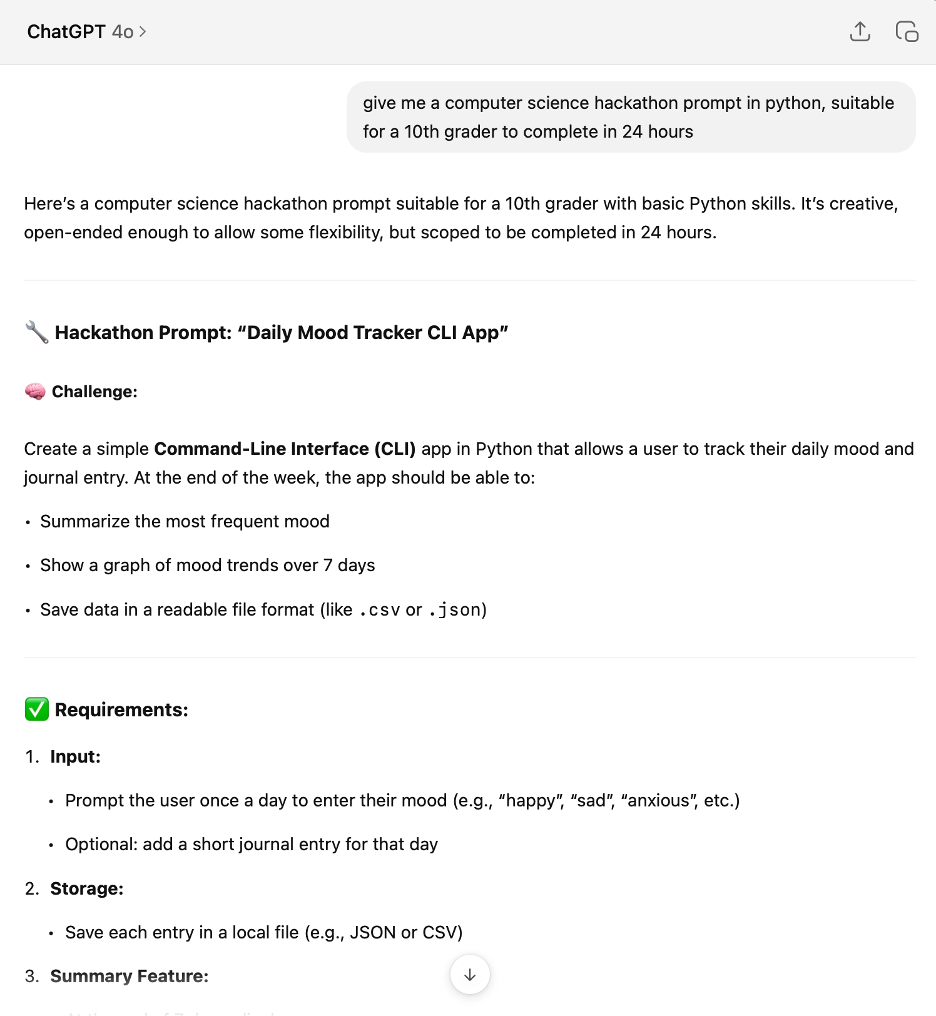

3. Ask AI to act as a historical figure and simulate a conversation with them
You can ask about their existing beliefs, how they would react to a modern-day problem, and who they were influenced by. This can lead to inspirational breakthroughs in analyzing the historical significance of a certain figure, event, or legislation. Double-check all historical dates and text references, as generative AI can produce inaccurate references that appear realistic but don’t exist.
For example, “simulate a conversation with me as Leo Tolstoy”
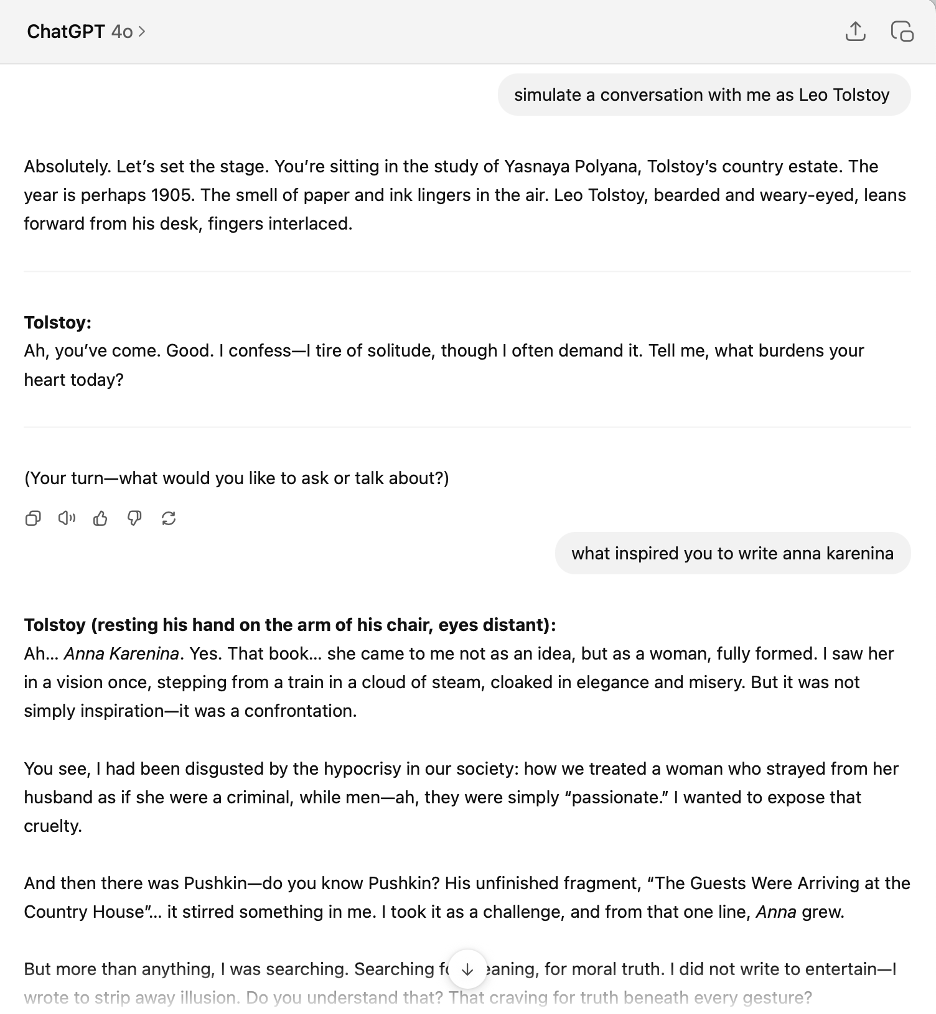
4. Gamify with AI to personalize your learning and create additional motivation
For example, “make a game to help high school students prepare for APUSH”
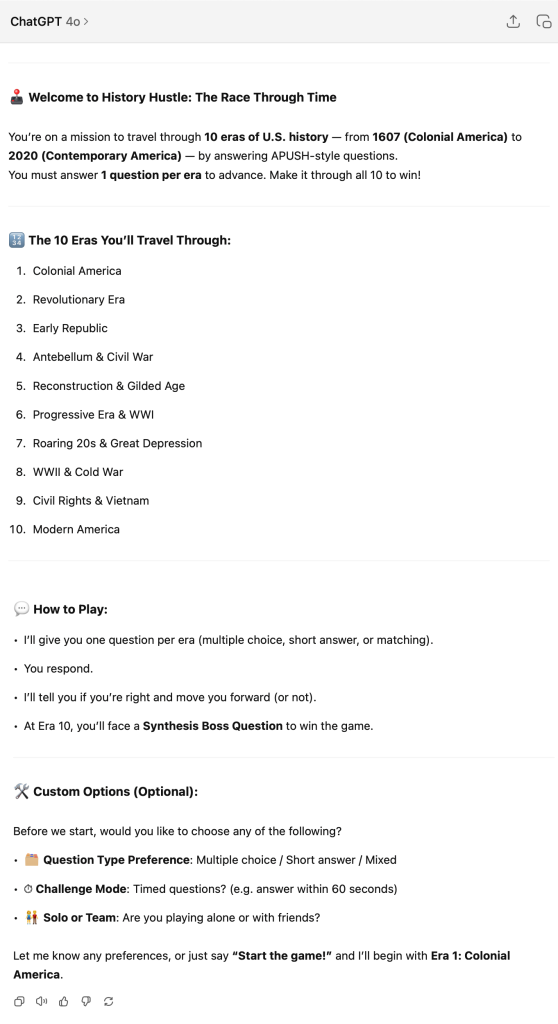
5. Participate in an AI-generated challenge, asking it to simulate real-world scenarios
Put your creative thinking to the test and gain insight into real-life experiences.
For example, “in this chat, simulate a stock market challenge to teach me (a high school student) about finance and economics”

How to Self-Check if You’re Using AI Responsibly
Each step of the way, and once you’ve completed your paper, ask yourself the following questions:
How much has the AI model changed my paper?
AI may suggest edits that you think about and write yourself, but it should not be writing edits that you directly accept and add to your paper. This is a key difference between AI-assisted and AI-generated, the former being the more responsible and commonly accepted option.
Is the AI helping me think, or is it thinking for me?
When using AI tools during the writing process, whether you’re brainstorming, researching, or drafting a conclusion, ask yourself: Am I using AI to deepen my thinking, or to replace it? Effective use of AI means it should support your ideas, not generate them for you. For example, while working on a STEM research paper or crafting a humanities thesis, AI might help you explore different angles or refine your argument. However, the core ideas, insights, and reasoning should come from you. If you find yourself accepting AI-generated ideas without questioning or adapting them, you may be skipping the critical thinking that’s essential to meaningful learning. Use AI to challenge and expand your thoughts—not to shortcut the process of thinking them through.
Did I write every single sentence in my paper?
AI should not produce any content, but it can guide you in thinking about certain topics, which you then write about yourself.
Does my paper sound different than my previous work?
Reread your previous academic papers and make a responsible, honest judgment on the level of writing skill and emotional depth between your past work and your AI-assisted paper.
Did I learn from my schoolwork/research paper, or did AI give me the answers?
If you were to pull up a blank piece of paper and write down everything you learned from writing this paper, how much would you remember? If you thought critically about a subject and thoroughly researched it on your own, you would remember takeaways, whereas if you only read the answers AI summarized for you, you may forget it more easily.
If my teacher asked me to explain how I wrote my paper, how much would I credit to AI?
This is typically the moment when students feel guilty and are more honest about their AI usage. If your paper was flagged for plagiarism and unoriginal thought, can you confidently defend yourself and prove that both your ideas and sentences are authentically yours?
Did I double-check all the AI-generated primary and secondary sources in my citations?
As mentioned above, AI can make up sources that don’t exist and “facts” that are untrue. If using AI for the research stage of your paper, always double-check with your library database. Do not take a quote from an AI chat transcript and add it directly into your paper.
Unlock Your Writing Potential: Students in Our Writing Competition Preparation Class Are More Likely to Secure Awards
How to Cite AI
Keep transcripts of your interactions with generative AI models. You should cite direct quotes, paraphrases, and any proofreading that AI generated in your paper. Follow this Brown University citing AI guide for APA, Chicago, and MLA style. See below an example of citing AI in MLA style from the Brown University guide:
Format:
“Description of chat” prompt. Name of AI tool, version of AI tool, Company, Date of chat, URL.
Example:
“Examples of harm reduction initiatives” prompt. ChatGPT, 23 Mar. version, OpenAI, 4 Mar. 2023, chat.openai.com/chat.
In-Text Citation Example:
(“Examples of harm reduction”)
Frequently Asked Questions
If I edit my AI-generated paper, is that still cheating?
Yes. The AI-generated paper is not your own. You did not conduct research, critically think about ideas, or practice your writing skills. It does not matter if you adjusted the paper to sound like you. This is still plagiarism.
Is Grammarly an AI tool?
Yes. Grammarly is a generative AI model, though it has fewer capabilities than ChatGPT. Grammarly will edit your sentences and, with the premium subscription, rewrite them according to your choice of tone. High school students can benefit from using Grammarly to correct simple grammar mistakes, such as punctuation placement, spelling, use of prepositions, and run-on sentences. However, they should be cautious of using the sentence-rewrite feature, as that may border on inauthentic work.
Grammarly vs. ChatGPT
Grammarly will not generate sentences, paragraphs, and papers from scratch, whereas ChatGPT will. It also cannot produce new ideas. Grammarly may be a more school-friendly option for editing academic writing than uploading your paper into ChatGPT. Grammarly is designed to help students learn about their grammar mistakes while writing, thereby improving their skills for the future. Using ChatGPT for proofreading may be too much of a shortcut for some teachers’ perspectives. Always ask your teacher before using AI for your paper.
Can professors/teachers/colleges detect AI in essays?
Yes, your teachers and college admissions officers can tell if you use AI in academic writing. Popular AI detection programs used by teachers include Turnitin, GPTZero, and Originality.AI.
Understand AI with Aralia
Learn how to use AI tools like ChatGPT to boost your writing—the right way. In this course, students will master responsible, ethical, and effective strategies for integrating AI into academic and English writing. Perfect for middle and high school students who want to enhance their skills and stay ahead in the digital age.

Responsible Use of AI in Academic and English Writing
This Responsible Use of AI in Academic and English Writing course is designed to teach students how to integrate artificial intelligence (AI) tools into their academic and English writing processes responsibly, effectively, and ethically.









